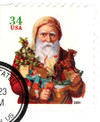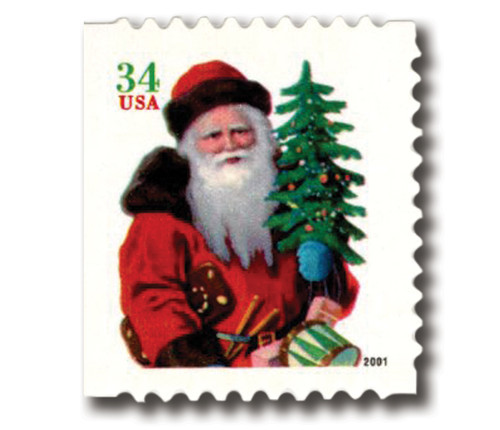
2001 34c Contemporary Christmas: Santa with Toy Horse, green denomination
# 3541 - 2001 34c Contemporary Christmas: Santa with Toy Horse, green denomination
$0.40 - $3.20
U.S. #3541
34¢ Santa with Horse
Contemporary Christmas
Vending Booklet
34¢ Santa with Horse
Contemporary Christmas
Vending Booklet
Issue Date: October 10, 2001
City: Santa Claus, IN
Quantity: 201,000,000
Printed by: Avery Dennison
Printing Method: Photogravure
Perforations: Serpentine Die Cut 11
Color: Multicolored
City: Santa Claus, IN
Quantity: 201,000,000
Printed by: Avery Dennison
Printing Method: Photogravure
Perforations: Serpentine Die Cut 11
Color: Multicolored
Our modern Santa Claus has his roots in ancient European customs of giving gifts on a special day in winter. Saint Nicholas, a fourth-century bishop, became the Christian figure associated with holiday gift-giving. The Dutch brought their version of St. Nicholas to America, calling him “Sinterklaas.” English settlers adopted him, pronouncing his name “Santa Claus.” The Santa Claus se-tenant stamps portray the familiar holiday character in chromolithographs that date from the 1880s to 1920.
U.S. #3541
34¢ Santa with Horse
Contemporary Christmas
Vending Booklet
34¢ Santa with Horse
Contemporary Christmas
Vending Booklet
Issue Date: October 10, 2001
City: Santa Claus, IN
Quantity: 201,000,000
Printed by: Avery Dennison
Printing Method: Photogravure
Perforations: Serpentine Die Cut 11
Color: Multicolored
City: Santa Claus, IN
Quantity: 201,000,000
Printed by: Avery Dennison
Printing Method: Photogravure
Perforations: Serpentine Die Cut 11
Color: Multicolored
Our modern Santa Claus has his roots in ancient European customs of giving gifts on a special day in winter. Saint Nicholas, a fourth-century bishop, became the Christian figure associated with holiday gift-giving. The Dutch brought their version of St. Nicholas to America, calling him “Sinterklaas.” English settlers adopted him, pronouncing his name “Santa Claus.” The Santa Claus se-tenant stamps portray the familiar holiday character in chromolithographs that date from the 1880s to 1920.











